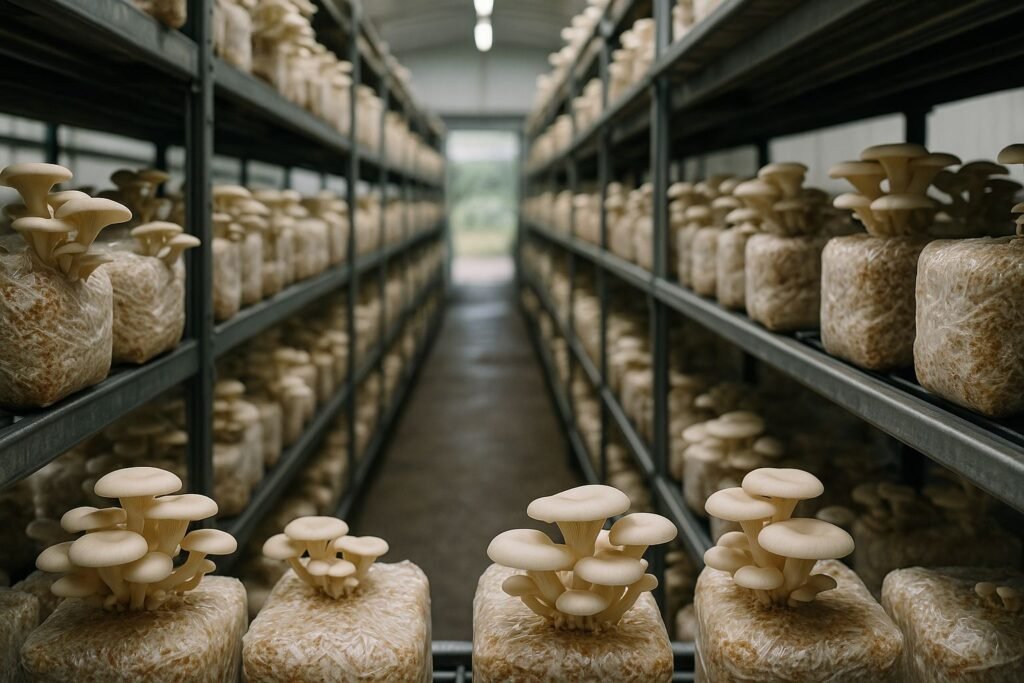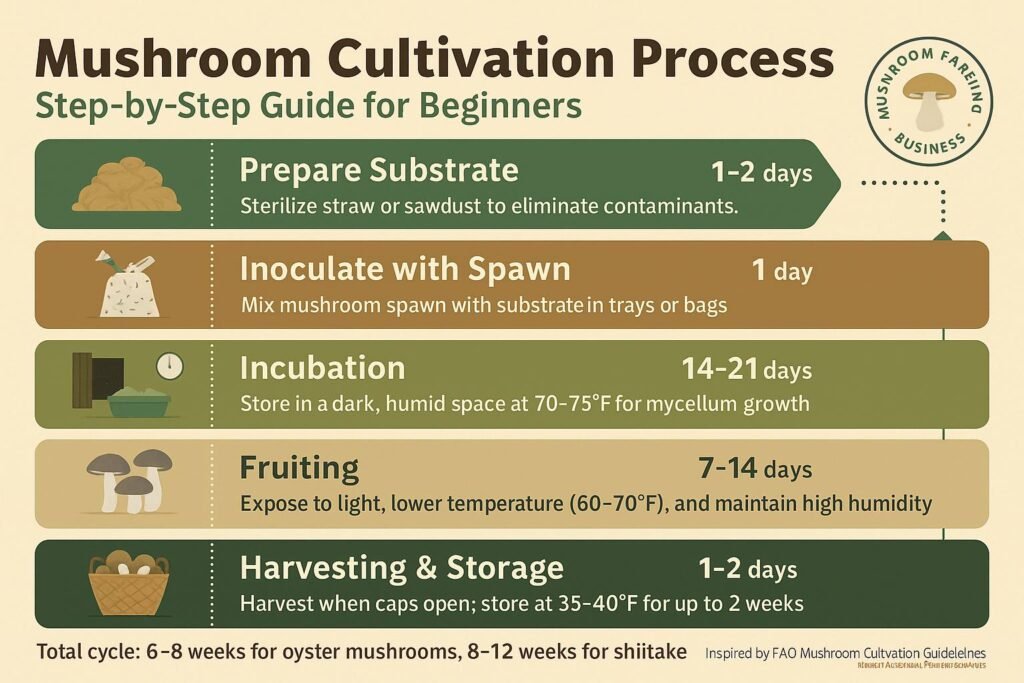Table of Contents
- Introduction
- Why Mushroom Farming is Profitable in 2025
- Step 1: Research the Mushroom Market in Your Area
- Step 2: Choose the Right Type of Mushroom to Grow
- Step 3: Create a Profitable Business Plan
- Step 4: Setup Your Mushroom Farming Infrastructure
- Step 5: Learn the Cultivation Process (Step-by-Step)
- Step 6: Marketing & Selling Your Mushrooms
- Common Mistakes to Avoid in Mushroom Farming
- Final Thoughts: Is Mushroom Farming Worth It in 2025?
- FAQs About Mushroom Farming Business
Introduction
The mushroom farming business is booming in 2025, driven by a surge in demand for healthy, organic, and plant-based foods across Western countries. With the global mushroom market projected to reach USD 71.62 billion in 2025, growing at a 10.2% CAGR, now is an ideal time to start a profitable mushroom farming business. Mushrooms are not only nutritious but also sustainable, making them a smart choice for aspiring entrepreneurs. Moreover, their short cultivation cycle and high yield make them perfect for beginners. In this guide, we’ll walk you through how to start mushroom farming, covering costs, planning, setup, and marketing strategies to ensure your success in this thriving industry. Whether you’re in the USA, Canada, or another Western market, this beginner-friendly guide has you covered.

Why Mushroom Farming is Profitable in 2025
Mushroom farming is a lucrative venture in 2025 due to several compelling factors. Firstly, the global mushroom market is expected to grow from USD 60.53 billion in 2024 to USD 105.54 billion by 2029, with the U.S. market alone valued at USD 3.24 billion in 2024, growing at a 9.4% CAGR. This growth is fueled by a consumer shift toward organic and plant-based foods, with mushrooms being a low-calorie, nutrient-rich option packed with vitamins, minerals, and antioxidants. According to the USDA, U.S. mushroom production reached 844 million pounds in 2019, with a value of USD 1.1 billion, and demand continues to rise, particularly for specialty varieties like shiitake and oyster.
Additionally, mushrooms offer a short cultivation cycle- often 6–12 weeks—allowing multiple harvests per year and high yields per square foot. For example, oyster mushrooms can yield 25–30 pounds per square foot annually. With potential returns on investment (ROI) of 50–100% depending on scale and efficiency, a mushroom farming business offers a recurring income stream. For instance, selling at USD 6–10 per pound to restaurants or farmers’ markets can generate substantial profits.
Step 1: Research the Mushroom Market in Your Area
Before diving into a mushroom farming business, research your local market to understand demand and opportunities. In the USA and Canada, oyster, shiitake, lion’s mane, and button mushrooms are highly sought after. Oyster and shiitake dominate due to their versatility and health benefits, while lion’s mane is gaining traction in niche wellness markets. According to a 2017 USDA-NASS report, specialty mushrooms like shiitake and oyster saw a 4% production increase, with sales reaching USD 96.2 million.
Consider whether you’ll sell wholesale to restaurants and grocery stores or retail at farmers’ markets. Wholesale offers bulk sales but lower margins, while retail allows higher prices but requires more marketing effort. Additionally, check local regulations for farm setup, permits, and food safety standards. For beginners, starting small-perhaps in a garage or basement-helps test the market before scaling.
Tip: Connect with local chefs or organic stores to gauge demand before investing heavily.
Step 2: Choose the Right Type of Mushroom to Grow
Selecting the right mushroom type is critical for a profitable mushroom farming business. Below is a comparison of popular varieties:
| Mushroom Type | Growing Difficulty | Profit Potential | Market Demand |
|---|---|---|---|
| Oyster | Easy | High | Very High |
| Shiitake | Medium | Medium-High | Growing |
| Button | Easy | Medium | Consistent |
| Lion’s Mane | Medium | High | Niche Market |
Oyster mushrooms are beginner-friendly, with low startup costs and high demand in restaurants. Shiitake mushrooms offer strong profits but require more expertise. Button mushrooms have steady demand but face competition, while lion’s mane appeals to health-conscious consumers due to its cognitive benefits. Research local preferences to align with market needs.
Step 3: Create a Profitable Business Plan
A solid business plan is the backbone of a successful mushroom farming business. Below is a breakdown of startup costs and financial projections:
Startup Cost Breakdown
| Item | Estimated Cost (USD) |
|---|---|
| Spawn (100 lbs) | $200–$500 |
| Substrate (straw, sawdust) | $300–$600 |
| Humidifier | $100–$300 |
| Trays/Bags | $100–$200 |
| Temperature Control | $200–$500 |
| Space Rental (if needed) | $500–$1,000 |
| Total | $1,400–$2,600 |
Monthly Expenses
- Utilities (electricity, water): $100–$200
- Labor (if hired): $500–$1,000
- Supplies (ongoing spawn/substrate): $200–$400
Projected Yield & Revenue
- Yield: 500 lbs/month (oyster mushrooms, 200 sq ft setup)
- Selling Price: $6–$10/lb
- Monthly Revenue: $3,000–$5,000
- Breakeven: ~6 months (assuming $2,000 startup and $1,000 monthly expenses)
A simple breakeven analysis shows that with consistent sales, you can recover your investment within 6–12 months. For a detailed plan, download our free PDF business plan template.
Step 4: Setup Your Mushroom Farming Infrastructure
Setting up your mushroom farming business requires minimal space—50–200 square feet in a garage, basement, shed, or greenhouse works well. Key equipment includes:
- Humidifier: Maintains 80–95% humidity
- Trays/Bags: For substrate and spawn
- Temperature Control: 60–75°F for most varieties
- Spawn/Substrate: Oyster mushrooms grow well on straw; shiitake prefers hardwood sawdust
Indoor vs. Outdoor Farming
- Indoor: Better control over conditions, year-round production, but higher setup costs.
- Outdoor: Lower costs, but weather-dependent and slower growth.
Source: FAO Mushroom Cultivation Guidelines
Step 5: Learn the Cultivation Process (Step-by-Step)

Here’s a step-by-step guide to the mushroom cultivation process, with estimated timelines:
- Prepare Substrate (1–2 days): Sterilize straw or sawdust to eliminate contaminants.
- Inoculate with Spawn (1 day): Mix mushroom spawn with substrate in trays or bags.
- Incubation (14–21 days): Store in a dark, humid space at 70–75°F for mycelium growth.
- Fruiting (7–14 days): Expose to light, lower temperature (60–70°F), and maintain high humidity.
- Harvesting & Storage (1–2 days): Harvest when caps open; store at 35–40°F for up to 2 weeks.
Total cycle: 6–8 weeks for oyster mushrooms, 8–12 weeks for shiitake.
Learn more about mushroom Farming on “How to Set up a Small Mushroom Farm in Your Backyard.“
Step 6: Marketing & Selling Your Mushrooms
To make your mushroom farming business profitable, focus on targeted marketing:
- Local Restaurants: Offer samples to chefs for bulk orders.
- Farmers’ Markets: Sell fresh mushrooms at $8–$12/lb.
- Organic Food Stores: Pitch organic certification for premium pricing.
- Direct Online Sales: Use e-commerce platforms or social media marketplaces.
Leverage local SEO by listing your business on Google Maps and using keywords like “mushroom business USA.” Social media platforms like Instagram can showcase your farm’s story and attract health-conscious buyers. For niche branding, emphasize organic or specialty varieties like lion’s mane.
Source: USDA Agricultural Marketing Resource Center
Common Mistakes to Avoid in Mushroom Farming
Avoid these pitfalls to ensure success:
- Over-investing without market research: Start small to test demand.
- Using poor-quality spawn: Source from reputable suppliers.
- Ignoring humidity & contamination: Monitor conditions to prevent mold.
- Skipping profitability planning: Calculate breakeven and ROI early.
Final Thoughts: Is Mushroom Farming Worth It in 2025?
A mushroom farming business in 2025 offers immense profitability potential due to rising demand, short cultivation cycles, and high ROI. Starting small allows you to test the waters with minimal risk, while long-term opportunities include expanding into processed products like powders or supplements. With the right plan, equipment, and marketing, you can turn a small setup into a thriving business.
FAQs About Mushroom Farming Business
How much does it cost to start a mushroom farming business?
Startup costs range from $1,400–$2,600 for a small-scale operation, including spawn, substrate, and equipment.
Can I start a mushroom farming business from home?
Yes, a garage or basement with 50–200 sq ft is sufficient for small-scale production.
Which mushroom is most profitable?
Oyster and lion’s mane are highly profitable due to strong demand and premium pricing.
How long until I earn a profit?
With a $2,000 startup and $3,000–$5,000 monthly revenue, you can break even in 6–12 months.
Pingback: 7 Most Profitable Crops to Grow in Canada - Agro Reality